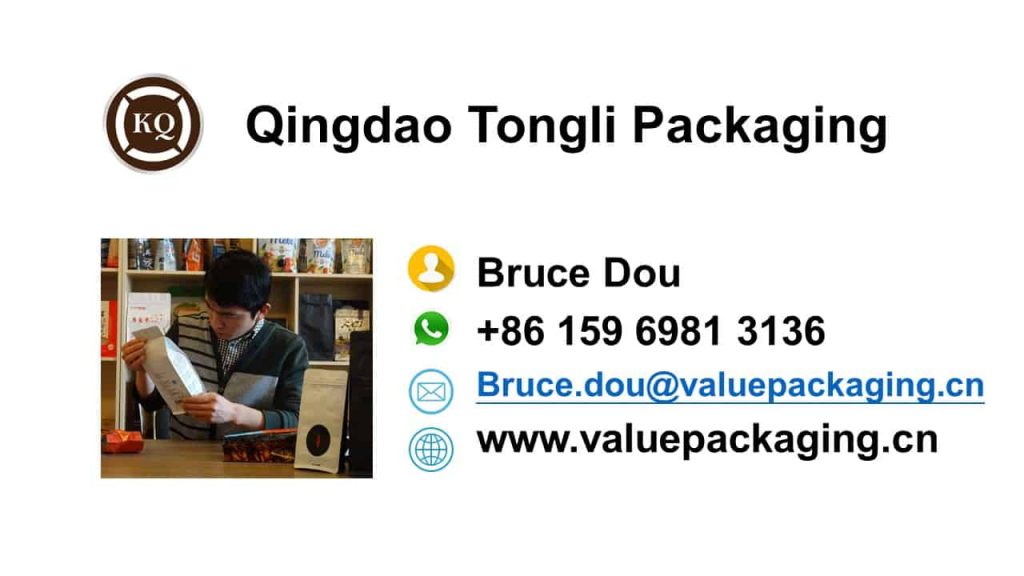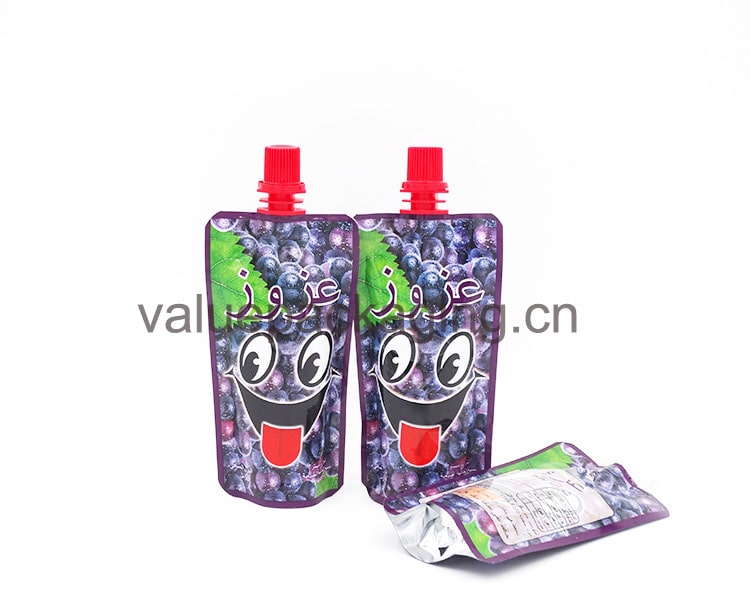
At present, stand-up pouches account for a large part of the packaging of juice products on the market. With a flexible combination of polymer and biopolymer film materials, self-standing juice pouches protect juice products during distribution while being more cost-effective. In addition, creative artistic designs can be printed on all sides of the stand-up pouch, covering all brand and sales information, making the final packaging much more attractive to consumers.
As a well-known flexible converter located in Qingdao, China, we are making the best use of the film materials in the market, listed below.
- fossil chemical polymer films
- Aluminum foil metal sheet
- vacuum metalized film materials
- Ceramic film substrates
- plant-based biopolymer materials
- biodegradable film materials
- compostable substrate films
- Fully recyclable substrate films
The quality of the packaging bag directly affects the market efficiency of the product, so in this article, we analyze the material composition of the 100g juice stand-up bag.
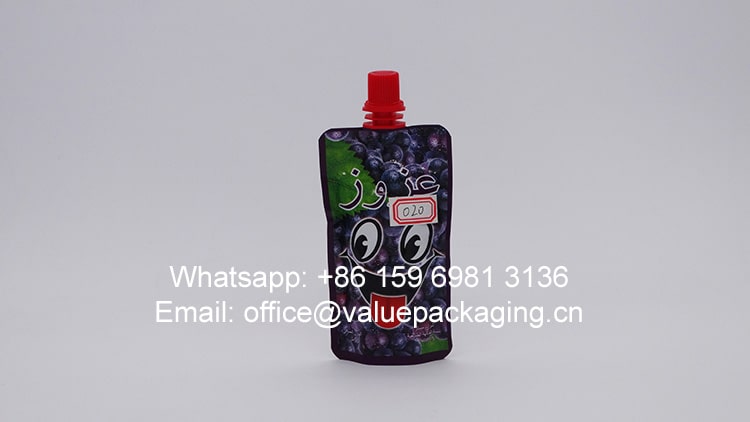
Ok, let’s get into the details of this standup screw cap spout bag.
pasteurization treatment
Pasteurization is a mild heat treatment method mainly used to kill pathogenic microorganisms in food while trying to maintain the nutritional components and flavor of food as much as possible.
Hot filling is usually performed immediately after pasteurization for secondary sterilization to improve the overall sterilization effect.
So there are some requirements for the material of the bag. Next, let us analyze the bag material suitable for pasteurization.
Packaging Foil Materials
The figure below shows the composition structure of this laminated foil material which is used to convert this standup juice bag.

The 100g juice stand-up pouch is made of 3 layers. The outer BOPP film is used as the printing substrate film, the VMPET foil Is used as the middle support layer, and finally, the LDPE film is used as the internal sealing layer.
Next, let’s get into a deeper understanding of each substrate film material.
BOPP Film
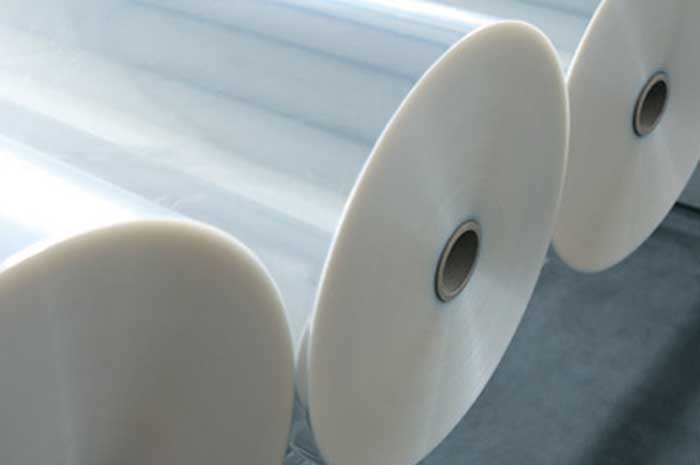
BOPP film is actually short for biaxially orientated polypropylene film, which is one of the most common print substrates in flexible packaging.BOPP films have many advantages, including:
- Clarity: Biaxially oriented films are very clear.
- Strength: They have high tensile properties and improved toughness
- Flexibility: They are more flexible
- Barrier properties: They have improved barrier properties
- Shrinkability: They can be made relatively easily shrinkable
Biaxially oriented polypropylene (BOPP) film is one example of biaxially oriented film. BOPP film can be produced using either a tubular or tenter frame process. In the tenter frame process, a thick extruded sheet is heated to its softening point and then mechanically stretched by 300–400%.
Biaxial orientation is a process that stretches a plastic film or sheet in two perpendicular directions to improve its mechanical properties. The process involves heating the film and then pulling it simultaneously in two different directions, which orients the polymeric chains parallel to the film’s plane.
Due to these good properties, BOPP films are widely used in packaging
VMPET Film
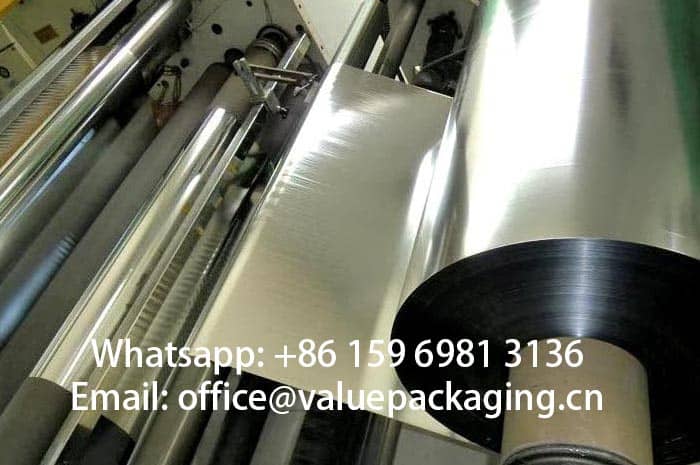
VMPET refers to the polyester aluminized film. It is a composite film material formed by coating a thin aluminum film on the surface of polyester film (PET) as the base material through processes such as vacuum coating
This material has good barrier properties and oxygen barrier properties. The aluminum coating has a good blocking effect on light, which can effectively prevent food, medicine, etc. from deteriorating due to light. It can also prevent oxygen penetration to a certain extent and reduce the product coming into contact with oxygen, thereby inhibiting oxidation reactions.
LDPE Film
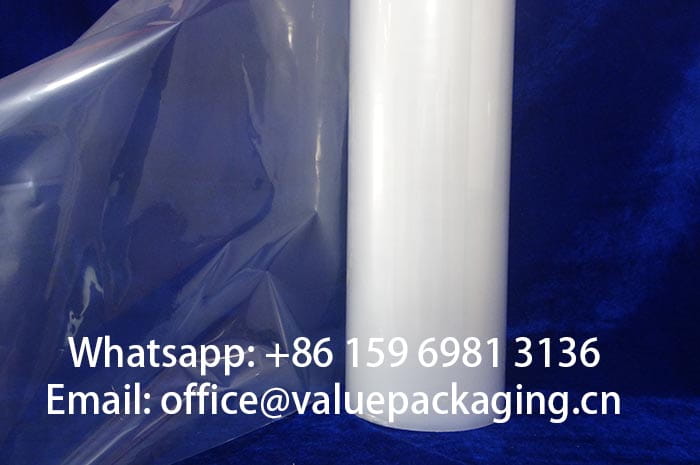
LDPE, means low-density polyethylene film, which is the most used inner sealing layer for standing juice bags. LDPE is also lightweight, easy to fabricate, and has good chemical and impact resistance. LDPE is recyclable and reusable, making it a popular alternative to traditional plastic. LDPE is nontoxic, non-contaminating, and has a high degree of break resistance. Most importantly, LDPE membrane can be modified against the requirement of specific products, and finalize the package with great seal strength and protection. The thickness of the LDPE membrane film will be decided against the particular application.
The customer artwork is printed reversely on the inner side of the first BOPP film layer in the gravure printing system. Then, these 3 layers are bonded together into a finished laminated foil material under the dry lamination or solvent-free lamination process.
Usually, we describe the finished laminate as BOPP/VMPET/LDPE foil. So, how does this foil structure perform when it is intended for standup juice bags? Will it break during the transit?
Great Standup Effect
As the outer layer, BOPP provides initial stiffness and strength. VMPET is located in the middle layer and enhances the barrier property and stiffness. LDPE foil, as the inner layer, ensures the sealing property and flexibility of the packaging. This structure cooperates with each other and helps to improve the standing effect of the packaging.
Of course, the thickness of a finished foil influences the standup effect of this juice bag after being filled. The thickness of the LDPE film used in this foil laminate is 80 microns You can see that the thickness of this finished juice daypack is around 300 microns in the picture below.
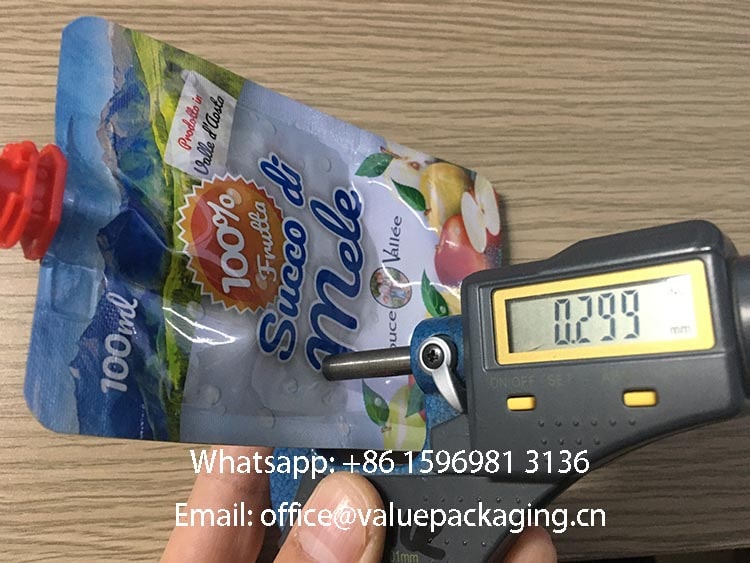
The video below shows well the standup effect of this 100ml orange juice standup sachet.
Mechanical Property
The spout package will protect the juice product during filling, transit, and distribution. Under the emergency circumstances of unexpected shock in delivery or packages falling off the goods shelf, the spout package will never be allowed to break. Can you ever imagine the leaked juice contaminating the cartons or the floor?
We put the mechanical property of this 100ml juice standup sachet on our top priority in our manufacturing plant. Serious measures are taken in our QC system, to assure each order is finalized with the expected result.
Let’s see the video, a drop test of a filled package is one of the most reliable ways to check if the package may burst under sudden sharp forces.
Here, we are going to fill 100ml water into this bag, perform the drop test from 1.6 meters high, 3 times, and check if it breaks.
Of course, two-layer structure PET/LDPE can also be intended for a 100ml juice spout sachet. Some customers may just choose this PET/LDPE foil bag with a relatively lower cost. However, the triplex foil laminate BOPP/VMPET/LDPE is able to present reinforced mechanical properties than the two-layer structure. You may reach us for a further analysis on the cost if you need.
Barrier Performance
Usually, the barrier performance of a multi-material laminate is evaluated by WVTR (short for water vapor transmission rate) and OTR (Oxygen Transmission Rate). The juice product will be kept away from these two elements to stay fresh as long as possible. However, please keep in mind that, the barrier property of this laminated foil is just a part of the measures taken to ensure the shelf life of juice products. The below table shows the typical value of the WVTR and OTR of this triplex foil laminate BOPP/VMPET/LDPE
| Item | Standard | Unit | Typical Value |
| Water Vapor Transimission Rate | ASTM E 96 | g/m2/24hr | 85 |
| Oxygen Transmission Rate | ASTM D 372-99 | cc/m2/24hr | 1.2 |
It is easy for the customers to understand this foil laminate is not of excellent barrier performance, as there is not any high barrier film layer in this foil structure. For some customers who have higher requirements for the flavors and freshness of their juice products, a foil laminate with higher barrier properties is inevitably needed.
In most cases, a layer of vacuum-metalized film, aluminum foil, or clear-coated polyester film is going to be included in the multi-layer foil materials. Through the below table, you can easily find out the typical values of moisture vapor transmission rate and oxygen transmission rate of common substrate film materials.

so, some reinforced foil structures are better protections for the freshness and flavors of juice products, with some available items listed below.
You may reach us for further ideas on each foil structure if you need any assistance.
Technical Data Sheet of 100ml juice standing bag
Here, we attach the specification sheet of this 100ml juice standup sachet based on foil laminate BOPP/VMPET/LDPE
More tests are included in this specification sheet with items available listed as below.
- Yield (grams per square meter)
- Tensile Strength (Mpa)
- Elongation Rate (%)
- Coefficient of friction, short as COF
- Solvents Left (mg/m2 )
- Sealing Strength (N/15mm)
- Sealing Conditions
- Bond Strength (N/15mm)
- Burst Strength (J)
- Anti-Puncture ability (N)
- Drop Test Ability (cm)
- Anti-pressure ability (kgs)
- Water Vapor Transmission Rate (g/m2/24hr)
- Oxygen Transmission Rate (cc/m2/24hr)
.
Compostable Packaging Materials
Compostable packaging materials are very similar to biodegradable materials. In most cases, people may not get a clear understanding of the difference between compostable and biodegradable. Generally speaking, compostable materials are based on biodegradable materials and when they break down, they will not cause harmful elements to the environment.
As to the materials used in our factory, the customers can just consider biodegradable equal to compostable.
The compostable packages are based on plant-based fibers like cellulose, or bio-mass like corn starch, cassava, or sugarcane. The resins derived from these resources are usually named bio-polymer, which can break down into inorganic elements under the functions of algae, bacteria, and other microorganisms.
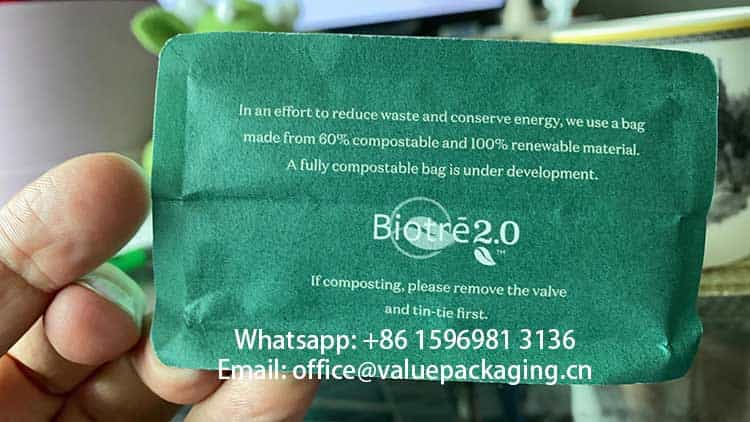
Premium-quality compostable standup sachets and rolls are produced in our plant, which are intended to meet the particular requirements of every product. You may reach us for further ideas if you are interested in compostable packaging materials.
Fully Recyclable Mono Materials
Compared with the high cost of compostable foil materials, actually fully recyclable materials sachets and rolls are flooding the market for lightweight products packages in the market at much lower prices. Mono materials packages mean each layer of the multi-layer foil is made of the same resin, which can be easily processed in the human recycling system and reused for other applications. This recyclable materials sachet largely reduces the rate of plastic polymer film packages ending in landfills.
Now, the mono-materials recyclable spout sachet can be well intended for juice from 50~250ml, with the barrier performance as good as traditional metalized film spout daypack. That’s good enough for the packages of juice products.
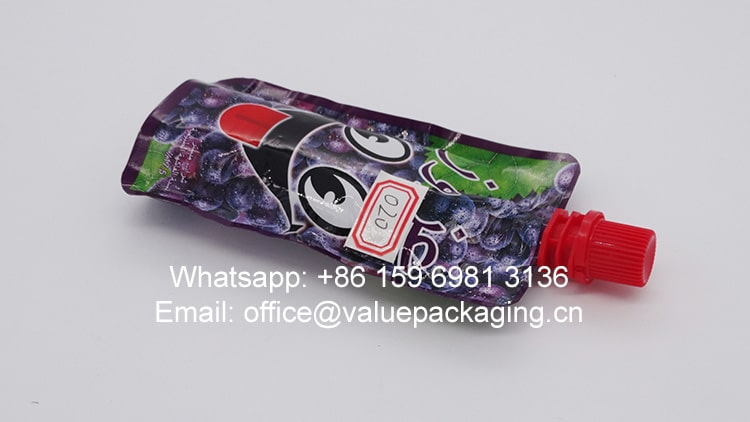
That‘s all. if you have any questions please contact us, and we will reply to you immediately.
